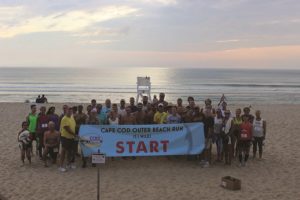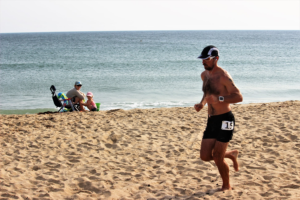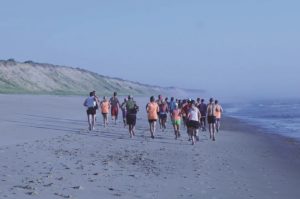WELLFLEET — The Cape Cod Outer Beach Half Marathon, scheduled for this Sunday, Aug. 14 at 7 a.m., is not for the faint of heart.
It’s 13.1 miles on sand, starting at Marconi Beach in Wellfleet and finishing at Head of the Meadow in Truro. Unlike a typical half marathon — where one’s feet slap against pavement, providing a firm surface for propelling oneself forward — in this race your feet sink deep into soft sand with every stride, making it nearly impossible to run.

Why subject oneself to such a torturous activity in the wee hours of a Sunday morning when one could be snuggling in bed?
Organizers and participants swear the experience is like nothing else.
“You’re running down one of the more beautiful seascapes in the world,” says Gordon Miller, one of the race directors. “It’s not developed: there are no boardwalks, no hotels right on the beach. It’s pristine.”
Louis Cote, who has participated in the event the past four years, agrees. “You watch the rising sun as you’re racing a half marathon, going north all the way,” he says. “You go by seal colonies, you go by fishing boats, you get to see those couples walking along the beach early in the morning. And you have sand dunes on one side and the ocean on the other.”
Cote, who set the event’s course record in 2015 with a time of 1 hour, 36 minutes, acknowledges that the race is, in fact, quite difficult.
“If you’re training for a half marathon on the beach, you might as well be training for a full marathon, because that’s what it’s going to feel like,” he says. “It takes a lot of strength to push off the sand.”
But that’s part of the appeal, Cote says. “You don’t see this kind of thing anywhere,” he says. “All the runners I know, I tell them they should do this once.”

Another thing that makes this race unusual: most of the participants compete barefoot.
“I have found that it is actually easier to do it without shoes, because your feet kind of need to feel the moving sand,” Cote says. “You don’t get that when you’re wearing shoes.” Cote has always competed barefoot and says that most lifeguards also run the race barefoot.
Cote incorporates barefoot sand running into his training each summer, which he says helps him remain injury-free. “I’ve had injuries go away from doing more sand running,” he says. “The fronts of your feet aren’t absorbing as much impact because they sink into the sand a little, so it gets dispersed into the sand.”
Cote says that barefoot sand running also helps strengthen the feet and ankles. It can lead to injury “only if you step on a rock, which I did this morning on my run,” Cote adds.
Not everyone opts to go barefoot. Cote says you’ll get the full experience either way.
“Whether you wear shoes or not, what’s special about it is the conditions are different every year,” he says. “One year it was nice soft sand all the way; another year it was rocky. You don’t know where the wind will go and you literally have the water lapping at your feet the entire time. You’re not going to experience that anywhere else.”
In Honor of Annie
The event began in 2014 when a group of six lifeguards decided to honor Annie Haggerty, a veteran lifeguard who died of skin cancer in 2013.

Haggerty loved to run, says Patty Greene, also a veteran lifeguard and a longtime friend of Haggerty’s. She ran from Coast Guard Beach to Race Point Beach — about 28 miles — several times, says Greene.
While the group was not prepared to run quite that far, Greene says, they wanted to do something to honor Haggerty. The idea of a half marathon was born.
After the first one, which had only six runners — all friends of Annie’s — Greene and the others decided they wanted to expand the event.
“I said, let’s take this to the next notch,” Greene says. “So, with the support of the National Park, Gordon Miller, my supervisor, and a number of lifeguards, we made it happen.”
The event now includes a four-person relay and a five-mile walk, which expands the number of people who can participate, according to race organizer Linda Fogel.
In the past, “It’s been small because [the half marathon] is a bit daunting,” Fogel says. “It’s a lot harder than running a road race.”
“Turning it into a relay was good because it got more people involved,” says Toby Davis, Haggerty’s former husband who comes to the event every year. “Turning it into a walk for some of us old farts was even better.”
Davis looks forward to the event each year despite the pain and loss associated with it. “It’s hard for me because it brings back memories of fonder days in my life, when Anne was alive,” he says. “But Anne would really appreciate knowing that this event is going on.”
Proceeds from the event support melanoma awareness and a memorial scholarship fund. Owen Wilson, Haggerty’s and Davis’s son who is a rising senior at Monomoy Regional High School, will be the first recipient, but Davis says the scholarship will eventually support more students. “As the race continues, after Owen graduates from college, it will continue as a scholarship fund, perhaps for lifeguards,” he says.

Davis emphasizes that the event is “not just for lifeguards and not just for the running community.” Rather, it’s a place for Annie’s friends and the broader Outer Cape community to get together and do something challenging, he says, as well as an opportunity to raise awareness about skin cancer.
Greene agrees: “You get tearful when you’re done because you’re just remembering her,” she says. “The run warms us all because she’s missed, but she has inspired a lot of us who were never runners.”
“I’ve raced all over the place,” Cote says. “But even though it’s one of the most challenging things I’ve done, it’s still one of my favorite things.”
